John Dann MacDonald was an American writer of novels and short stories. He is known for his thrillers.
Travis McGee is a fictional character, created by American mystery writer John D. MacDonald. McGee is neither a police officer nor a private investigator; instead, he is a self-described "salvage consultant" who recovers others' property for a fee of 50 percent. McGee appeared in 21 novels, from The Deep Blue Good-by, first published in 1964, to The Lonely Silver Rain in 1984. In 1980, the McGee novel The Green Ripper won a National Book Award in a one-year Mystery category. All 21 books have the theme of a color in the title, one of the earliest examples of detective/mystery fiction series to have a 'title theme'.
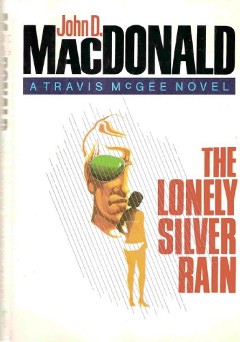
The Lonely Silver Rain (1985) is the 21st and final novel in the Travis McGee series by John D. MacDonald. The work was published a year prior to the author's death, and was not intentionally the end of the series. It is also notable for the introduction of McGee's daughter Jean, who he unwittingly sired with the now-deceased love interest Puss Killian from the ninth book in the series: Pale Gray for Guilt. At the end of the book McGee has taken all of his cash in hand except for a few hundred dollars and placed it in a trust fund for his newly met teenage daughter, and needs to go back to work as a "salvage consultant." The author's death prevented any further development of this new character and plot line.
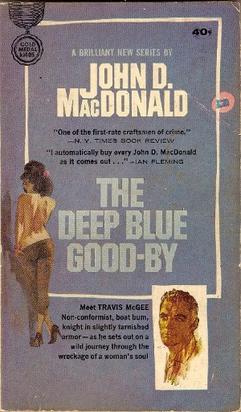
The Deep Blue Good-by is the first of 21 novels in the Travis McGee series by American author John D. MacDonald.

The Green Ripper (1979) is a mystery novel by John D. MacDonald, the 18th of 21 in the Travis McGee series. It won a 1980 U.S. National Book Award in the one-year category mystery.

The Quick Red Fox (1964) is the fourth novel in the Travis McGee series by John D. MacDonald. In it, McGee is hired to aid a fictitious Hollywood star named Lysa Dean who is being blackmailed with revealing photographs.

A Deadly Shade of Gold (1965) is the fifth novel in the Travis McGee series by John D. MacDonald. The plot revolves around a solid gold Aztec statuette, and takes McGee from his home of Florida to Mexico and Los Angeles. The cover bills this novel as a "double-length adventure" and is about twice as many pages as the previous Travis McGee novels.

Bright Orange for the Shroud (1965) is a sixth novel in the Travis McGee series by John D. MacDonald. The plot follows McGee as he attempts to salvage the money of friend Arthur Wilkinson after the man is defrauded in a semi-legal confidence scheme involving a land deal.

Darker than Amber (1966) is the seventh novel in the Travis McGee series by John D. MacDonald. The plot begins when McGee and his close friend Meyer are fishing underneath a bridge and a young woman, bound and weighted, is thrown over the bridge. It was adapted into a 1970 film of the same name.
Darker than Amber is a 1970 film adaptation of John D. MacDonald's 1966 mystery/suspense novel, Darker than Amber. It was directed by Robert Clouse from a screenplay by MacDonald and Ed Waters.
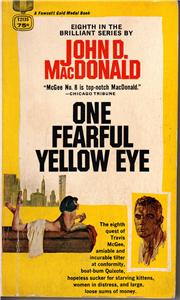
One Fearful Yellow Eye (1966) is the eighth novel in the Travis McGee series by John D. MacDonald. The plot revolves around McGee's attempts to aid his longtime friend Glory Doyle in her quest to uncover the truth about her late husband and the blackmail which made over half a million dollars of his fortune disappear. It is largely set in Chicago, rather than the usual McGee haunt of Florida. When Fortner Geis dies, it becomes clear that his fortune was swindled out of him in his last months. McGee tracks down the money and eventually builds a romantic relationship with Fortner's daughter, Heidi Trumbill.

Pale Gray for Guilt (1968) is the ninth novel in the Travis McGee series by John D. MacDonald. The plot revolves around McGee's investigation into the death of his close friend Tush Bannon, who he suspects has been murdered because of his refusal to sell his waterfront property to developers. In terms of series continuity, Pale Gray for Guilt is particularly important in that it involves a love interest, Puss Killian, who is central to the final book: The Lonely Silver Rain.
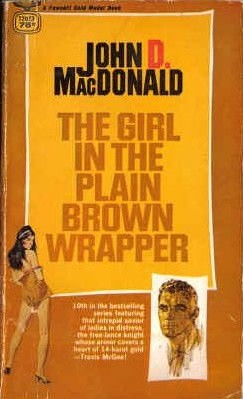
The Girl in the Plain Brown Wrapper (1968) is the tenth novel in the Travis McGee series by John D. MacDonald. The plot focuses on McGee's investigation of a beautiful young woman who is mysteriously losing her mind without any apparent physical or mental disease. Along the way, he discovers various troubling facets to the small Florida town where she resides.
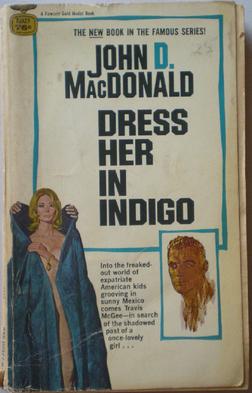
Dress Her in Indigo (1969) is the eleventh novel in the Travis McGee series by John D. MacDonald.

A Tan and Sandy Silence (1971) is the thirteenth novel in the Travis McGee series by John D. MacDonald. The plot begins with Harry Broll, husband of McGee's longtime friend Mary, shows up at his houseboat The Busted Flush with a gun, threatening McGee and accusing him of hiding Mary aboard. The rest of the novel involves McGee's search for Mary.

The Scarlet Ruse (1972) is the fourteenth novel in the Travis McGee series by John D. MacDonald. The plot revolves around McGee's investigation into some extremely valuable rare postage stamps which have been stolen. McGee investigates the problem of Hirsh Fedderman's missing stamps on behalf of his friend and sidekick Meyer. By the end of the book, McGee has put himself and Meyer in mortal peril.
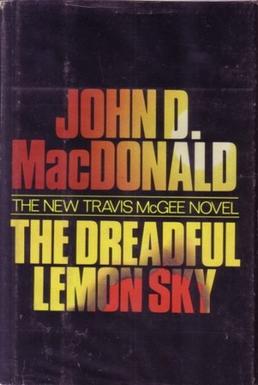
The Dreadful Lemon Sky (1975) is the sixteenth novel in the Travis McGee series by John D. MacDonald. It is the 87th novel in The Top 100 Crime Novels of All Time as compiled by the Mystery Writers of America.

The Empty Copper Sea (1978) is the 17th novel in the Travis McGee series by John D. MacDonald. In it, McGee looks into the apparent drowning of Hub Lawless in a boating accident. His $2 million insurance policy leads some to believe he has faked his death.
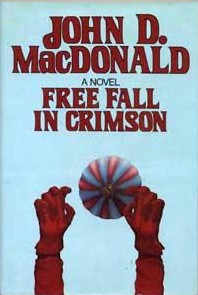
Free Fall in Crimson (1981) is the nineteenth novel in the Travis McGee series by John D. MacDonald. In the plot McGee sets out to investigate the death of an ailing millionaire, and encounters a motorcycle gang, pornographic movie-makers, and balloonists. The book also revives the character of Lysa Dean from The Quick Red Fox, an early novel in the series. In the finale, McGee's longtime friend Meyer is terrified into submission by the main villain and judges himself a failure because his inaction almost led to disaster. This moral dilemma is resolved in the next novel, Cinnamon Skin.
Travis McGee is a 1983 American TV movie based on the 1978 novel The Empty Copper Sea by John D. MacDonald. It was the second film adaptation of the Travis McGee series. It was made by Warner Bros.















